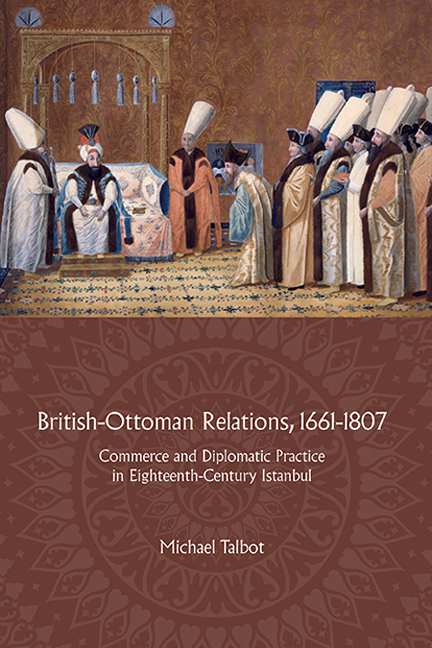 British-Ottoman Relations, 1661-1807
British-Ottoman Relations, 1661-1807 Book contents
- Frontmatter
- Dedication
- Contents
- List of tables and figures
- Acknowledgements
- Note on languages, place names, dates, and currencies
- List of abbreviations
- Introduction: De/re-constructing the history of British–Ottoman relations
- 1 The framework of relations
- 2 The office of ambassador
- 3 Trade and diplomatic finances
- 4 Gift-giving
- 5 Diplomacy as performance
- 6 Negotiating disputes
- Conclusions: De/re-constructing British–Ottoman diplomacy
- Bibliography
- Index
- Frontmatter
- Dedication
- Contents
- List of tables and figures
- Acknowledgements
- Note on languages, place names, dates, and currencies
- List of abbreviations
- Introduction: De/re-constructing the history of British–Ottoman relations
- 1 The framework of relations
- 2 The office of ambassador
- 3 Trade and diplomatic finances
- 4 Gift-giving
- 5 Diplomacy as performance
- 6 Negotiating disputes
- Conclusions: De/re-constructing British–Ottoman diplomacy
- Bibliography
- Index
Summary
Cultures of gift-exchange
When the Ottoman government appointed ambassadors to reside in London, a number of important and unprecedented questions arose. One of the most pressing was, what gifts should the sultan send to the king? This generated a number of discussions, one of which concerned cultural appropriateness. In 1799, during the ambassadorship of İsmail Ferruh Efendi, the Ottoman government dispatched a gift to George III. The grand vizier, Yusuf Ziyaüddin Paşa, wrote a note to Selim III requesting his approval for the design of this latest present:
It was petitioned to the dust at the imperial feet for your consideration that a number of aigrettes with the base made from diamonds, by God's will, were fashioned as a gift to go to Britain [İngiltere'ye gidecek hedīye]. The image of the Great Word [i.e. Allah] was deemed to be contrary to the [British religious] community [ḫilāf-ı millet], and, although appropriate to some extent, the requirements of making a portrait from diamonds instead made it too expensive to set. Therefore, if each will have an image of the radiant tuğra [the sultan's caligraphic monogram] made from a reasonable number of diamonds, the value will not be compromised, the radiant tuğra will be honoured, [and] the top of the aigrettes will be headed with the distinction of your imperial name.
This idea met with the approval of the sultan, who wrote, ‘my vizier: very beautiful [pek güzel]! The matter has been considered well. The image of the tuğra is appropriate.’ Here we see a concern not only for the financial value of the gift (mālīyet) but above all for its suitability (münāsib). A religious image was not appropriate, but one that was a symbol of the sultan's authority, the tuğra, was seen as a fit decoration for the aigrette. Here, we can see the Ottoman state, at the highest level, giving careful consideration to the form and meaning of diplomatic gifts to be sent to foreign courts. For the British embassy in Istanbul, gifts were a key link in the cycle of friendship. So far, we have seen how British–Ottoman relations were largely geared towards supporting trade, and how the British ambassadors relied on that trade for their finance.
- Type
- Chapter
- Information
- British-Ottoman Relations, 1661-1807Commerce and Diplomatic Practice in Eighteenth-Century Istanbul, pp. 105 - 140Publisher: Boydell & BrewerPrint publication year: 2017
